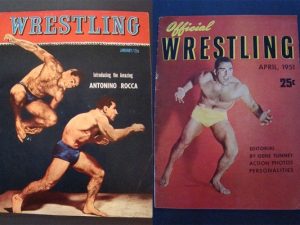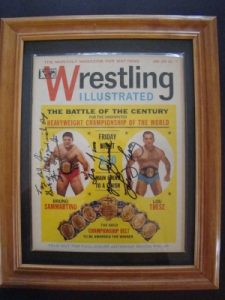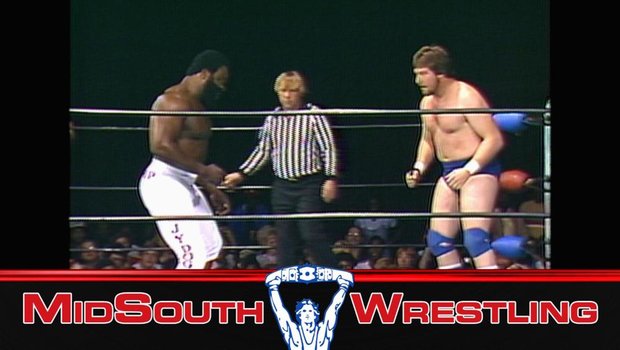From RF Videos
Back to the attic!
Jim shows off several wrestling calendars from the 1950’s with Verne Gagne and Antonio Rocca on the covers.

He also has a copy of the Verne Gagne wrestling board game.
Corny explains how Verne was made the U.S. champ in order to tour the Unitied States as the top guy in places that could not book NWA champ Lou Thesz often enough.
Fritz Von Erich’s first match in Dallas is highlighted in a 1950’s program. The article plugs “Jack Adkisson”, local football stud, making his debut.
An early “Capitol Wrestling” program has Toots Mondt, Vince McMahon Sr. and other notable names from the “WWWF” on the cover.
Corny framed a Charlotte newspaper article on Jim Crockett buying several promotions in 1987 as his business was booming. Next to the article is another clipping from a year later, which covered JCP selling to Turner.
Jim was at ringside snapping pictures for the famous Jerry Lawler vs. Andy Kaufman match. Newsweek contacted him to buy some stills, but Corny had been shooting in black and white for the Memphis program, and thus was unable to sell them their desired colored shot.
Kaufman called his own shot after Lawler piledrove him and told the ref he wanted an ambulance called. The show was stalled for 25 minutes as the fans pelted Kaufman’s body with trash as he lay in the ring. Lawler got on the house mic and screamed “Instead of an ambulance, maybe we should call you a Taxi!” The crowd popped, however Corny saw Danny Davis feed Lawler the line.
Corny digs out a program from 1941 as well as a magazine which featured an article penned by Jack Brickhouse. He also has “Arena” magazines from the 30s.
Bearcat Wright decided he wasn’t going to do any jobs for a promotion after he became their champion. One night his scheduled opponent was replaced by “Judo” Gene Lebell. Wright ran off and didn’t look back.
Jim Londos was a huge draw in the 30s. Attendance records were set everywhere. The WWF’s Kevin Dunn liked to brag about their attendance in each city when the Attitude boom hit, so Corny would piss in his Cheerios by pointing out Londos’ attendance records from wherever they happened to be.
We see a Roy Shire San Francisco program with Ray Stevens facing Pat Patterson. Another program has a majestic Buddy Rogers image with the World title draped over his abdominals.
Danny Hodge was put on his hometown phonebook cover. Of course Jim has a signed copy.
Bruno Sammartino and Lou Thesz was the dream match of the 60’s. Corny has a magazine cover teasing the match, signed by both men. Jim explains that Thesz wanted 100 grand to lay down for Bruno, and Bruno had no interest in working the NWA champion schedule, so the match never came off.

Jim has a 1937 program signed by 4 of the men on the card including the Dusek brothers.
Thousands of other programs and magazines from way back are laying on the shelves as Corny walks around. Quite an impressive and tempting sight.
The first issues of “The Wrestler” and “Inside Wrestling” from the 60’s are shown. It seems odd to me that they predate Pro Wrestling Illustrated, since PWI was far and away the number one magazine of note when I was a youngster.
Comic books were Jim’s first love, but once he found out wrestling magazines existed he went gaga collecting those.
Jim runs down his piles and piles of random magazines that came and went about wrestling. He even has international magazines.
A Japanese magazine paid Jim to send them Memphis pictures for them to publish. By the end of the 1970s, the teenage Corny was making up to a thousand bucks a week selling photos and working for Jerry Jarrett on the programs. He ended up taking a pay cut when he became a manager a few years later. The pictures he’s showing in these Japan magazines are flooring me. It’s crazy that the little Podunk Memphis promotion was being touted overseas.
Back to a formal interview…
Jerry Jarrett was a quiet guy, so going from him as a boss to Bill Watts was a culture shock.
Louisiana had little in the way of other sports to watch, so wrestling was a big part of the entertainment culture.
Fans would stop wrestlers all around town and give them best wishes for their big fight coming up. The marks believed these guys were the toughest men in the state.
Promoter/wrestler Leroy McGuirk stayed in the business despite being blind. He ended up bringing Bill Watts in as a business partner. They eventually split because Watts wanted to use new ideas and McGuirk was stuck in his ways. Watts ended up putting Leroy into retirement.
Grizzly Smith was involved in a plane wreck and never flew again after that. He ended up driving everywhere in Mid-South, sleeping in his car and whatever else it took to make his shots. He was also Watts’ top stooge. Smith seemed to have spies in the locker room.
Danny Hodge was the toughest pure fighter the business may have ever seen. Hodge ended up having his career ended when he fell asleep at the wheel and crashed his car into a creek. Hodge broke his neck, but held his head up with his hand as he crawled out of his flipped car and kept it held up as he walked down the road for help.
“Bad Bad” Leroy Brown used Jim Croce’s song as an entrance theme as early as 1977, becoming one of the first ever in history to use music. Lawler used music on occasion to make a big match stand out. Gorgeous George used music in the 50’s.
Ernie Ladd would make guys explain their psychology during a match and if they couldn’t justify why they did something, then the guys realized their errors and grew as performers.
Buck Robley was a good booker, but he also wanted to be one of the boys. This led to conflict between the office and the locker room.
Killer Karl Kox invented the brainbuster. Kox played a loon and would cut promos with an invisible man standing next to him.

Dick Murdoch talked the same way in real life as in his promos. He had great athletic gifts despite being out of shape. He possessed real knock out power in his hands.
Watts and Ladd differed on the potential of Ray Candy. Ladd put him over in the ring and they drew money on top feuding thereafter.
JYD was booked perfectly by Watts. This included an incident where Watts fired Ernie Ladd as booker after Ladd booked JYD to work Scott Irwin for 20 minutes to test him out. Bookers are suppose to get people over, not book them to fail. Lesson learned.
Nick Gulas would not let the Fabulous Freebirds use music in their early days. Jerry Jarrett was ok with it in Memphis. Michael Hayes got heat with the office with his attitude and they were shipped off soon after. This led to their Mid-South run which made them stars as they feuded with JYD.
Paul Orndorff and Bob Backlund trained together under Eddie Graham in Florida. Orndorff had come from the NFL and yet the wrestling training killed him.
Porkchop Cash had a great body and could bump well. His jive got over on the promos too.
Terry Taylor got over big in the Mid-South for an angle where Mr. Wrestling II left Magnum T.A. to take 10 belt lashings after they lost a tag team match. Taylor stepped in and took half the blows for his friend Magnum.
Taylor ended up being an office stooge and now is friendly with Vince Russo, so Corny is no longer high on him.
Watts took Bill Dundee’s goofy Memphis angles and gimmicks and twisted them to give them a harder edge. Dundee ended up booking for a year and a half and Mid-South was never more successful.
Jim Ross broke TV formats down to seconds. He and Corny got along as both had strict organizing habits in their booking and layouts.
It was obvious Magnum TA was going to be a star as he had the look and the basic skills that made everyone think he had a great chance to be a draw.
Mr. Wrestling II was originally planned to be the one turned on during his angle with Magnum T.A., but II was old, cranky and wanted to avoid fans, so he was a more natural heel at that point.
Butch Reed was a great talent, and made up an important cog in the upper tier of the Mid-South roster.
Dr. Death was green and didn’t know how strong he really was. He ended up being partnered up with Hercules and Cornette, which Jim loved as no angry fans were going to get past those monsters.
The Superdome was dark, so Corny can’t explain what it was like to work in front of such massive crowds. The noise told him that he was going to make a lot of money though.
Corny got tapes from everywhere in the 80’s EXCEPT the WWF. He saw a couple of Tuesday Night Titans and thought Vince was making fun of/killing the business. He would seek out Macho Man, Ricky Steamboat and other top notch workers stuff though.
WCW ended up being so bad that Corny left and he only went to the WWF to make some cash since SMW wasn’t taking off and the WWF made him a good offer.
JCP was foolish to buy Mid-South/UWF because Watts would not have been selling the thing if making money was possible.
Gary Hart turned Crusher Broomfield into One Man Gang. Hart deserves credit for polishing Gang up into a draw and a better worker than his younger days.

Eddie Gilbert won esteem from Watts and was given many hats to wear behind the scenes and in front of the camera in the UWF.
Gilbert came to SMW at a time where they needed a shot in the arm because Corny had already snagged all the other good southern talent during SMW’s first year or two. Cornette was willing to let Gilbert book his own stuff. Gilbert made one TV taping, then vanished. Gilbert snuck down to Puerto Rico and took the booker job there. He never bothered telling Corny. They never saw one another again.
Memphis was good for breaking in talent, but Watts took guys and made stars out of them.
Watts had a young roster because he had a long demanding schedule. If you could hack it, you’d make a lot of money. In 1984 Corny made six figures working for Watts.
Bobby Eaton would determine his workrate for a match based on many fans were in the crowd.
During one six-week stretch there, the Express got one day off. 103 days in a row was Corny’s record there for most days worked. When they got burnt out and asked for a break Watts took them off Houston, New Orleans and other big money dates and left them the spot shows. Message received.
Back to the attic~!
Corny got the chance to see The Sheik work live in Cincinnati, but it was past the promotion’s prime and the crowd was small.
5 territories were based within 4 hours of Louisville, so Corny was never far from the action if he wanted variety.
Corny did attend a fan convention in Florida and was able to take in a card there.
We are shown Arizona programs from 1948 with Dory Funk Sr. headlining.
The 1947 wrestling almanac has pictures of all the big stars that just missed out on the boom in the 50’s when TV hit huge.
A picture of the original “Dutch Mantel” from the 40’s makes it appear to be mobster gimmick.
The 1948 “Yakima Sport-a-gram” has the Swedish Angel on the cover.
Corny has the records that Jerry Lawler, Jesse Ventura, Adrian Street, Jimmy Valiant, Fred Blassie, and others released. The Wrestling Album 1 and 2 are also in the pile.
A 1956 Hawaiian program features Gene Kiniski, Dick Beyer and Rikidozan, among others.
Corny wished he could have worked for Eddie Graham and Sam Muchnick just for historical reasons. Working for Dick the Bruiser would have been cool too since his wrestling was among the first things to attract Corny.
A book in 1937 called “The Fall Guys” exposed the business. The book explained how angles, booking and gimmick finishes were done. Corny blames this partly for why wrestling tanked during World War 2. Bill Longson kept St. Louis very serious and the city drew big houses all throughout the war.
A 1938 “TV Guide” type of magazine is shown with wrestling being exposed on the cover.
The only expose that didn’t kill the business was when Eddy Mansfield went on 20/20 in 1984. The hype was so great around Hulk Hogan, Mr. T and Wrestlemania that they were able to weather the storm. It didn’t hurt that the WWF product was goofy and not taken too serious to begin with.
Corny shows off his first autograph book. The babyfaces would go to the concession stand for food or beer, which allowed the fans to hunt them down. The heels avoided this so they would not be attacked.
A manager’s licence in 1982 cost Cornette 5 dollars.
A program with Jim Londos from 1938 is under glass along with some ticket stubs from the era.
A wrestling poster is hanging up with a picture of Jack Long…who you may ask? Harley Race in 1964 in one of his early gimmicks.
The Dick the Bruiser vs. Alex Karas angle where they brawled in a bar to get heat ended up not drawing at the box office.
Another poster from Britain has Tiger Mask (Sammy Lee) and a young Chris Adams on it.
Final thoughts: These DVDs ran about 6 hours. Getting the chance to see a bunch of Corny’s stuff was truly the highlight of this set. RF Video did a fine job on the production, which is a nice change of pace for them.


